Are you attending trade shows and feeling like your marketing efforts fall flat? Crafting a show-stopping trade show marketing plan might be the key to transforming your trade show experiences. In a sea of exhibitors, it’s easy to get lost in the crowd and struggle to stand out. However, with a well-thought-out and strategic trade show marketing plan, you can make a powerful impact that leaves a lasting impression on attendees.
In this blog, we will walk you through the essential steps to create a trade show marketing plan that not only captures attention but also generates leads, boosts brand visibility, and drives your business toward unparalleled success.
What are Trade Shows?
Trade shows are industry-specific events that bring together businesses, professionals, and experts within a particular niche. These events offer a stage for businesses to exhibit their offerings, establish connections with colleagues, interact with potential customers, and acquire knowledge about the latest advancements in their sector. Prominent trade shows often take place in city convention centers and span multiple days. Meanwhile, local trade shows might occur in local arenas or hotels, enabling nearby businesses to connect with potential clients.
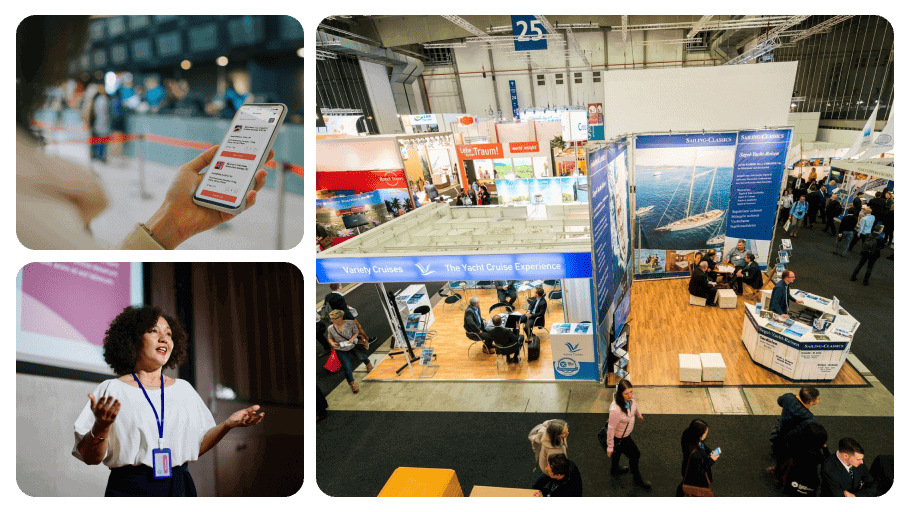
Why Should You Attend a Trade Show?
Attending a trade show can be a game-changer for businesses and professionals alike. It presents a unique opportunity to connect, engage, and thrive in your industry. Whether you’re an established company looking to expand your market share or an entrepreneur seeking exposure, trade shows offer a wealth of benefits that are hard to replicate through other marketing channels
Benefits of Trade Show Marketing for Businesses
Trade show event marketing offers various benefits that can significantly impact a business’s growth, brand recognition, and overall success.
1. Lead Generation
Trade shows serve as magnets for individuals already invested in a particular industry. These attendees represent a valuable source of potential leads, as their interest aligns with your business offerings. By setting up a booth, you create an opportunity to capture their contact information, effectively kickstarting the lead-generation process. The real-time nature of trade shows allows you to engage with these leads on the spot, enabling swift qualification and initiating the sales journey.
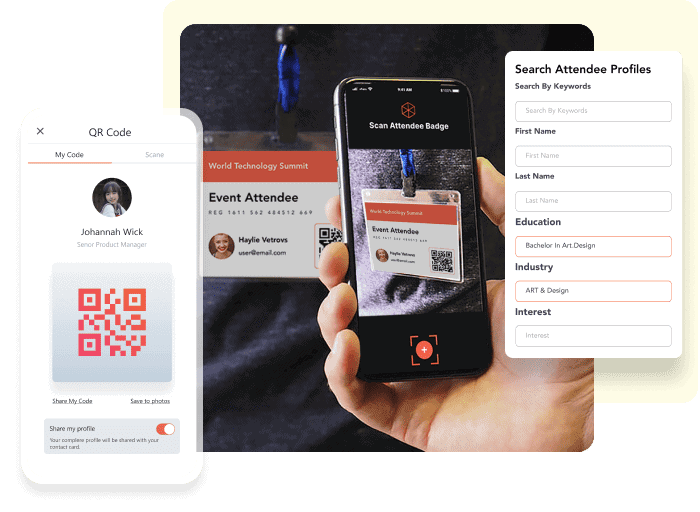
Jake’s Finer Foods hosted a virtual food show with vFairs which turned out to be a unique win-win situation for both the exhibitors and customers because of the quick lead-generation process. Instead of long queues and slow registration processes, the straightforward online registration form facilitated an impressive 278 unique registrations.
2. Brand Exposure
Participating in a trade show positions your brand in front of a diverse audience including your target customers, industry peers, competitors, and even potential partners. This level of exposure significantly enhances your brand’s visibility, helping it stand out from the noise in the market.
Moreover, trade show branding can lead to greater brand recognition, making your company more memorable and relevant in the minds of potential customers. The impressions made during the event can resonate long after it’s over, leaving a lasting impact on the attendees’ minds.
3. Product Launches
Trade shows offer a platform like no other for introducing new products or services. With a captivated audience actively seeking industry innovation, the event provides the ideal setting to create a buzz around your latest offerings. The captive attention of attendees, coupled with potential media coverage, generates excitement and immediate interest, translating into swift sales and ongoing curiosity post-event.
4. Market Insights
Participating in trade shows isn’t just about showcasing your own products; it’s also a golden opportunity to gather invaluable market insights. By observing competitor presentations, networking with peers, and engaging in conversations with attendees, you can gain a deeper understanding of emerging trends, shifting customer preferences, and even strategies employed by your competitors. This intelligence serves as a valuable foundation for informed business decisions, whether in product development or trade show marketing campaigns.
5. Immediate Feedback
Interacting directly with attendees is one of the main trade show marketing strategies. It offers an unparalleled chance to receive instant feedback on your products and services. Attendee feedback provides real-time insights into what resonates with your target audience and what might need improvement. This candid feedback loop enables businesses to make on-the-spot adjustments, ensuring higher customer satisfaction and product refinement.
6. Relationship Building
While trade shows are a fantastic avenue for meeting potential clients, they’re equally beneficial for nurturing existing relationships. Face-to-face interactions at these events offer a personal touch that goes a long way in reinforcing your connections with clients and partners. Strengthening these relationships can lead to repeat business, referrals, and mutually beneficial collaborations down the line.
The Canadian Health Food Association (CHFA) hosted a virtual trade show with the aim of building relationships and facilitating optimal engagement between exhibitors and attendees. Retailers had the option to engage in live video, audio, or text chats in order to interact with the manufacturers and develop a closer understanding of their products and gain more knowledge.
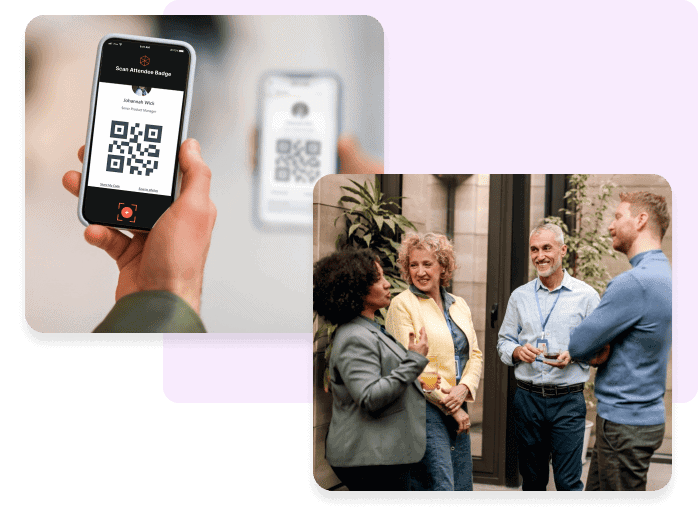
7. Media Exposure
Trade shows naturally attract media attention, creating a unique chance for your business to gain coverage in various industry outlets. Media representatives and influencers present at the event might spotlight your products or innovations, boosting your brand’s credibility and increasing its reach through coverage in publications, blogs, and news stories.
8. Cost-Effective Marketing
Considering the focused and engaged audience that trade shows attract, the investment required often proves to be cost-effective. While there are initial expenses involved, the ability to engage with a concentrated group of individuals already interested in your industry reduces marketing waste. The potential leads and contacts gained can lead to significant returns compared to broader marketing efforts.
9. Customer Loyalty
Meeting existing customers in person at trade shows allows you to strengthen your relationship with them. Face-to-face interactions provide a chance to express gratitude, address concerns, and offer personalized solutions. These interactions foster a sense of loyalty and connection, encouraging customers to stay loyal to your brand and even recommend your products or services to others.
10. Word-of-Mouth Referrals
Satisfied customers often share their experiences with others. Positive word-of-mouth referrals generated at trade shows can have a powerful impact on your business’s reputation and growth. Encourage attendees to spread the word by delivering exceptional experiences and creating memorable interactions that attendees will talk about long after the event ends.
11. Boost in Sales
The culmination of all these factors often results in a tangible boost in sales for businesses that effectively participate in trade shows. Directly engaging with potential customers, converting leads on the spot, and exposing your offerings to a qualified audience frequently leads to a spike in immediate and post-event sales. This impact can extend well beyond the event’s duration, contributing to your business’s sustained growth.
Harbor Wholesale‘s virtual trade show with vFairs is a worth-mentioning example here that resulted in a 35% increase in sales as compared to their previous trade shows. The team recognized that vFairs had all the aspects of an in-person trade show, and the immersive environment looked like a real event. These features included an animated lobby with avatars, an exciting exhibit hall with customizable booths, a realistic auditorium with speaker sessions, and much more.
How to Prepare for a Trade Show as an Exhibitor
1. Set Clear Goals
Start by defining your objectives for the trade show. Are you aiming to generate a specific number of leads, launch a new product, increase brand awareness, or foster industry connections? Setting clear and measurable trade show goals will guide your overall strategy and help you measure your success.
2. Develop a Budget
Allocate a budget that covers all the expenses related to your trade show participation, including event technology, booth rental, travel costs, trade show marketing materials, staff wages, and any other associated fees. A well-defined budget ensures you allocate resources effectively and avoid overspending.
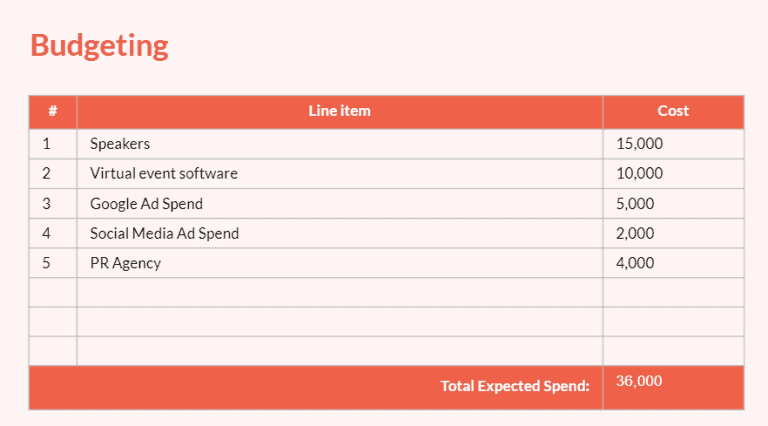
3. Identify the Best Trade Show
Research and choose trade shows that align with your target audience and industry focus. Consider factors such as the event’s location, attendee demographics, and the reputation of the trade show within your industry. By analyzing these critical elements, you can make informed decisions that align your participation with the most relevant and impactful trade shows for your business.
4. Create a Trade Show Marketing Strategy
Design a comprehensive trade show marketing strategy to promote your participation before, during, and after the event. This could include trade show advertising, email campaigns, social media promotions and press releases to build anticipation and attract attendees to your booth.
5. Utilize Social Media
Leverage your social media platforms to create buzz around your trade show presence. Share sneak peeks, behind-the-scenes content, and event-specific announcements to engage your audience and encourage them to visit your booth.
For example, video promos are a versatile piece of collateral you can share through your social media accounts. The more people that watch the video, the more chances there are of them signing up for your event.
6. Finalize Vendors
If you’ll be working with vendors for booth design, materials, or technology, make sure to finalize contracts and arrangements well in advance. Clear communication with vendors ensures your booth setup aligns with your brand’s vision.
7. Use Technology
You can enhance your trade show booth with technology by using interactive displays and touch screens to engage visitors. Check-in apps can provide a seamless experience to on-site attendees. You can also reach a wider audience through live streaming and guide attendees with a dedicated event mobile app.
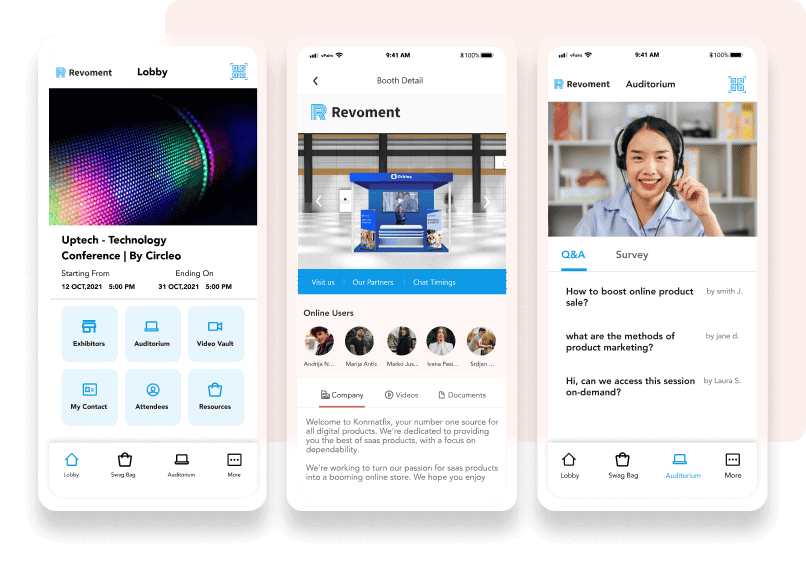
8. Create an Eye-Catching Booth
Design a visually appealing booth that reflects your brand’s identity and captures attendees’ attention. Use captivating graphics, signage, lighting, and layout to make your booth stand out amidst the crowd. Apart from creating an attractive booth, here are 4 steps to mastering booth flow at your trade show:
9. Plan Engaging In-Booth Presentations and Demos
Develop a schedule of engaging presentations, product demonstrations, or interactive activities that resonate with your target audience. Engaging content keeps visitors interested and provides opportunities for deeper interactions.
10. Follow Up
Create a post-show follow-up plan to capitalize on the leads and connections you’ve made. Reach out to the leads you’ve collected with personalized emails, calls, or follow-up meetings to nurture their interest and convert them into customers.
8 Essential Trade Show Marketing Materials
Success at a trade show hinges on careful planning and ensuring you have all the essential tools to showcase your brand in the best possible light. Whether you’re a seasoned exhibitor or a first-time trade show participant, this comprehensive list of essentials will help you make the most out of your trade show experience and elevate your brand to new heights
1. Business Cards
Timeless classic, business cards are still the go-to networking tool and one of the top trade show strategies. Ensure your cards are professionally designed and carry all the vital contact information to make connecting with you a breeze.
2. Social Media Templates
Leverage the power of social media to build buzz around your participation. Pre-designed social media templates will help you create eye-catching posts that promote your presence and attract visitors to your booth.
You can craft ready-to-use templates for various content types e.g. carousels for LinkedIn, designs for advertisements, and a reservoir of content ideas. This strategic approach allows you to produce tailored content across different social platforms. Moreover, it ensures you effectively engage your audience and showcase your booth’s attractions to capture attention and draw attendees.
3. Postcards
Be creative with eye-catching postcards showcasing your offerings, strategically placed to captivate attendees and help them remember your brand. Elevate the experience by including a QR code on the postcard. If distributed before the event, it can guide them to the registration page. Cards distributed at the entrance of the venue can swiftly lead to your exhibit booth.
4. A Stand-out Stand
Your booth is your storefront, so make it unforgettable. Invest in a visually appealing and interactive booth design that reflects your brand’s personality and captivates visitors.
5. Lead Capture App
A lead capture app is used to collect and manage information about leads at events like trade shows, conferences, and exhibitions. These apps are designed to streamline the process of gathering contact details and other relevant information from individuals who express interest in a company’s products or services.
With the vFairs Lead Capture App, event organizers and exhibitors can easily scan attendee badges, QR codes, or input data manually, while also having the option to include notes about each lead. Exhibitors can also label leads as hot, warm, or cold, making it easy to prioritize follow-up. The app then allows the seamless integration of collected leads with CRM and Martech solutions. This not only simplifies data management but also helps event organizers demonstrate the value of their events by providing tangible metrics and insights on the quality and quantity of leads generated.

6. Branded Swag
Everyone loves freebies! Offer branded swag items like pens, notepads, or tote bags to visitors. Useful and attractive trade show swag will keep your brand top-of-mind long after the trade show ends.
7. Trade Show Giveaways
Organize a giveaway or contest that draws attention to your booth. Whether it’s a product demonstration or an interactive game, make sure it aligns with your brand message and resonates with the audience. Reusable water bottles, notebooks, tote bags, customized pens, phone accessories, mini plants, or succulents are some of the unique trade show giveaway ideas.
For example, at Event Tech Live in London, vFairs took a unique approach by giving away baby succulent plants as giveaways. This natural and memorable gift added a touch of green to the event and left attendees with a living keepsake that represented growth and connection as well as vFairs message of promoting sustainability.
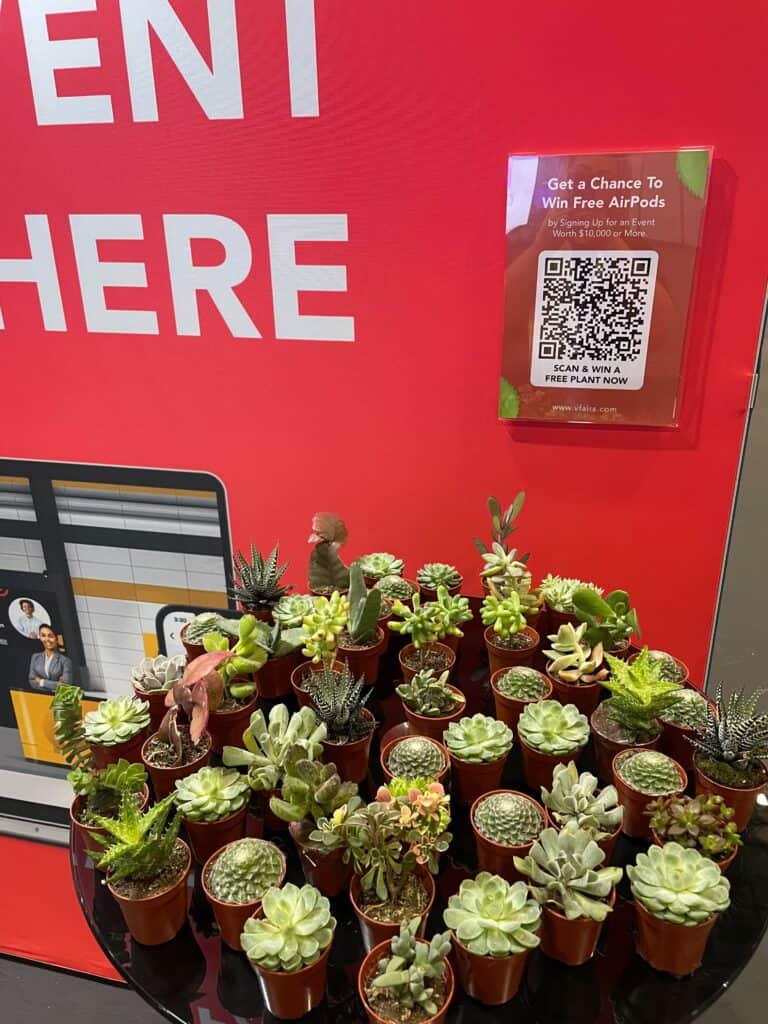
8. Clothing with Your Business Logo
Outfit your team in branded clothing to create a cohesive and professional appearance. Plus, it’s like free advertising as your logo gets seen by everyone at the event. Branded clothing makes it easier for people to figure out who’s on your team. This way, attendees can easily spot your team in the crowd and know who to approach for questions or help.
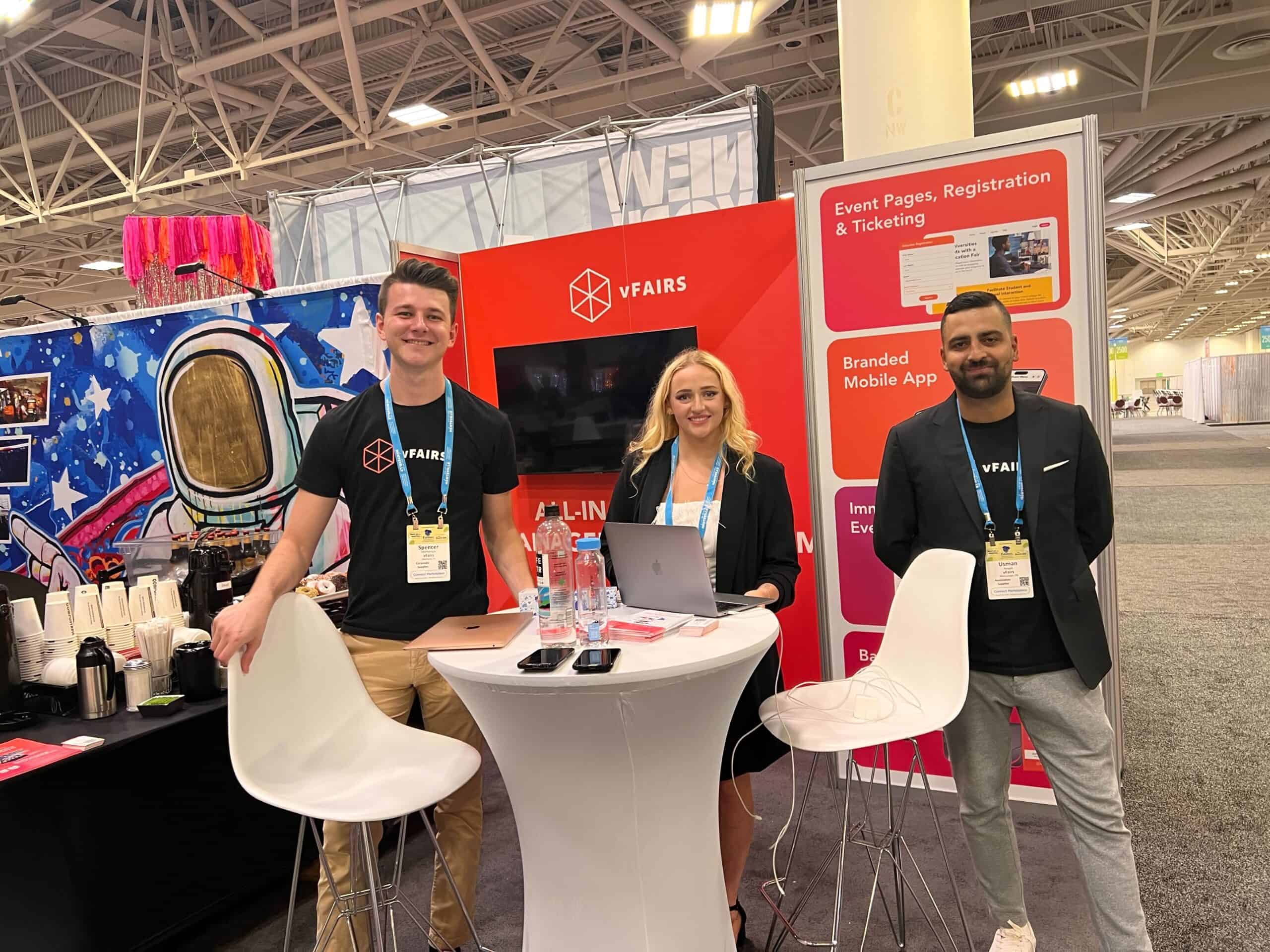
Common Trade Show Planning Mistakes to Avoid
In the fast-paced world of trade shows, effective planning can make the difference between standing out in the crowd and getting lost in the shuffle. Every detail, from booth design to promotional materials, plays a crucial role in making a lasting impression on attendees. However, amid the excitement and anticipation, common mistakes can easily slip through the cracks and hinder your trade show’s success. Here are a few mistakes to avoid:
1. Last-Minute Planning
Don’t wait until the last moment to get ready for the trade show. If you do, it can end up costing you more money, and you might not have many choices for your booth. Plus, you won’t have enough time to tell people about it. It’s a good idea to start preparing 2-3 months ahead so you have a better idea of what to do.
2. Ignoring Objectives
Failing to define clear objectives for the trade show can result in a lack of focus and direction. Always establish specific goals to guide your trade show strategy and measure your success.
Having well-defined objectives means deciding what you want to accomplish at the trade show. This could be things like getting a certain number of leads, introducing a new product, or creating brand awareness. These objectives give you a purpose and help you create a plan to achieve them.
3. Overlooking Budget Management
If you don’t handle your budget well, there are two main problems that can arise:
- Overspending: If you don’t keep track of your expenses, you might end up using more money than you should, which can put a strain on your company’s finances.
- Allocating Funds Inadequately: If you don’t plan how much to spend on different things, you might run out of money for important aspects like creating engaging booth designs or marketing materials.
Both of these issues can affect your overall trade show marketing efforts. You might not have enough money to create an attractive booth or run effective promotional activities, which could lead to a less successful trade show experience.
4. Neglecting Pre-Show Marketing
Forgetting to tell people about your presence at the trade show before it happens can mean fewer people coming to your booth. It’s important to do some marketing before the event to get people excited and interested.
You can work with the event organizers to mention your participation in their announcements. You could also make posts on social media about it. Another idea is to create content on your own social media pages that talks about what you’ll be showing at the event. Sending emails to your customers is also a good way to let them know you’ll be there. These things can help get more people to visit your booth.
5. Inadequate Staff Training
Not giving your booth staff enough training can cause you to miss out on chances to connect with people. When your staff knows what they’re doing, they can talk to visitors well and show your brand in a good way.
One way to train them is to practice talking to them like you’re in the booth. You can also talk about common questions customers might ask and how to answer them. Make sure they know how to use any technology you’ll have at the booth. With good training, your staff can make the most of the event and make your brand look great.
6. Neglecting Follow-Up
Failing to follow up with leads and contacts gathered during the trade show can squander valuable opportunities. Having a plan for follow-up is important because it keeps those potential customers engaged.
You could send them emails or messages to thank them for visiting your booth. You could also provide them with more information about what your company offers. This communication helps to keep the connection alive and shows that you value their interest.
How to Measure Trade Show Effectiveness
Measuring the effectiveness of a trade show is essential to determine the success of your participation and identify areas for improvement. While trade shows can be a powerful marketing tool, their impact on your business needs to be quantified to justify the investment and refine your future strategies. Let’s look at a few key metrics:
1. Lead Generation
This metric measures the number of potential customers who have shown interest in your products or services during the trade show. Leads are individuals or companies that provide their contact information, indicating a willingness to engage further with your business. This metric highlights your ability to attract and capture the attention of potential customers.
2. Sales Conversion
Sales conversion tracks the percentage of leads collected during the trade show that eventually turn into actual sales. This metric demonstrates the effectiveness of your follow-up strategies, the quality of your leads, and the overall impact of the trade show on your revenue generation.
3. Return on Investment (ROI)
ROI quantifies the financial success of your trade show participation. By subtracting the total costs associated with the trade show (such as booth rental, travel expenses, marketing materials, and staff salaries) from the total revenue generated, you can determine whether the event was financially beneficial.
4. Brand Awareness
Brand awareness measures how familiar attendees are with your brand before and after the trade show. By surveying attendees, you can assess changes in brand recognition, perception, and recall, helping you understand if your trade show presence positively impacted brand visibility.
5. Booth Traffic and Engagement
Monitoring booth traffic involves counting the number of visitors to your booth, while engagement focuses on their interactions. Tracking these metrics helps you understand the appeal of your booth’s design, activities, and staff interactions.
6. Social Media Engagement
This metric evaluates the impact of your trade show participation on social media platforms. By measuring metrics like the number of mentions, followers gained, and engagement with your trade show-related content, you can gauge the online buzz created by your presence.
7. Competitive Analysis
This involves assessing your performance relative to your competitors at the trade show. By analyzing their booth traffic, promotional activities, and overall impact, you can identify strengths, weaknesses, and areas for differentiation.
What’s Next?
Investing in marketing efforts for the trade show you’re participating in is crucial. This investment has the potential to not only nurture your sales opportunities but also amplify the visibility of your brand’s presence through social interactions.
In addition to the aforementioned marketing suggestions, it’s essential to contemplate establishing a brand community and broadcasting your participation in various events. This community can be cultivated on an online platform preferred by your primary audience.



